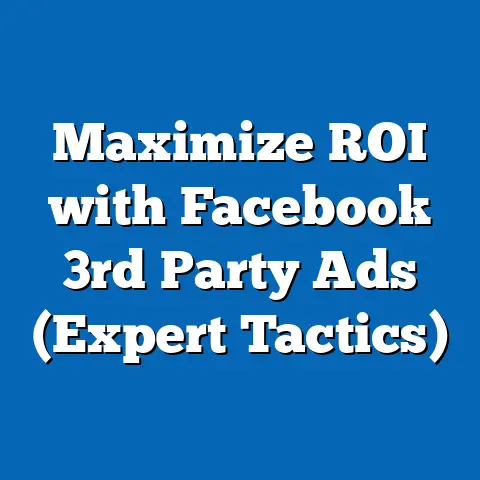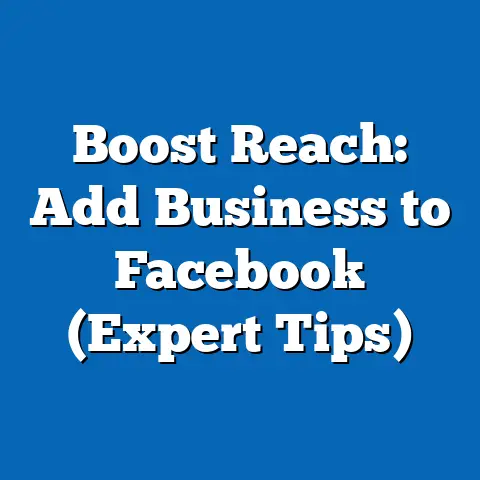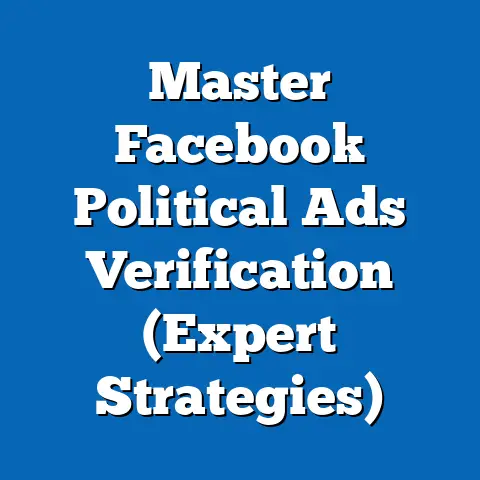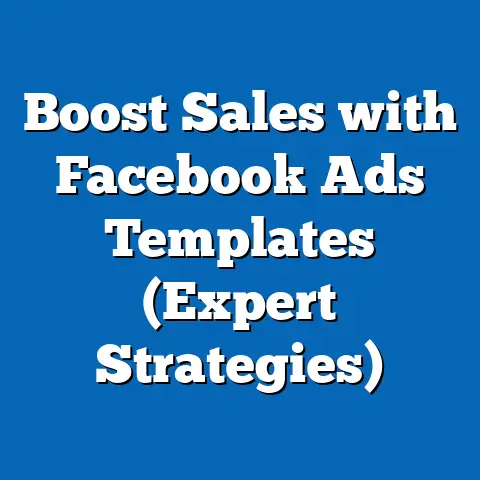Boost Ads Without Facebook Conflicts (Savvy Solutions)
Facebook advertising, when done right, can be an absolute game-changer for businesses. I’ve seen firsthand how a well-crafted campaign can skyrocket brand awareness, drive sales, and build a loyal customer base. The platform offers a wealth of tools and resources, making it easier than ever to reach your target audience. However, it’s not all sunshine and rainbows. The path to Facebook ad success is often riddled with complexities and potential conflicts. From navigating the ever-evolving advertising policies to crafting compliant and engaging content, advertisers can face numerous challenges that can lead to ad disapprovals or even account bans.
The key to running successful Facebook campaigns without running into conflicts lies in understanding and adhering to the platform’s advertising policies. It’s about being proactive, not reactive. It’s about crafting compelling content that resonates with your audience while staying within the boundaries set by Facebook. In this article, I’ll share some savvy solutions that will help you boost your ads without facing those dreaded Facebook conflicts. We’ll dive deep into understanding the platform’s advertising policies, crafting compliant content, targeting the right audience, testing and optimizing your ads, and dealing with conflicts and rejections. Let’s get started!
Understanding Facebook’s Advertising Policies
Facebook’s advertising policies are the backbone of its advertising ecosystem. They exist to ensure a safe and positive experience for users, and it’s crucial to understand them if you want to avoid ad disapprovals or account bans. I’ve seen countless businesses, especially smaller ones, get caught off guard by these policies, resulting in wasted time, money, and opportunities.
The policies cover a wide range of topics, including:
- Prohibited Content: This includes anything that is illegal, discriminatory, or promotes violence. It also covers misleading or deceptive claims, as well as content that infringes on intellectual property rights.
- Prohibited Practices: These are practices that manipulate or deceive users, such as cloaking, using deceptive redirects, or engaging in clickbait tactics.
- Restricted Content: This includes content that is subject to certain restrictions, such as alcohol, gambling, and dating services. These require special permissions and may be subject to specific targeting limitations.
- Personal Attributes: Ads must not directly or indirectly assert or imply personal attributes. For example, you can’t target an ad that says “Are you struggling with debt?” because it implies the user has financial difficulties.
One of the most common reasons ads get rejected is misleading content. Facebook takes a hard stance against ads that make false or exaggerated claims about products or services. I remember working with a client who was promoting a weight loss supplement. Their initial ad claimed that users could lose “10 pounds in a week with no exercise.” Unsurprisingly, the ad was rejected due to its unrealistic and unsubstantiated claims. We had to revise the ad to focus on the product’s ingredients and benefits in a more realistic and compliant way.
Another common pitfall is promoting prohibited products. Facebook prohibits the promotion of certain products and services, such as firearms, ammunition, and illegal drugs. Even if your product is legal in your jurisdiction, it may still be prohibited on Facebook.
Inappropriate targeting can also lead to ad rejections. Facebook’s targeting options are powerful, but they must be used responsibly. You can’t target ads based on sensitive personal attributes, such as race, ethnicity, religion, or sexual orientation.
To successfully navigate these policies, it’s essential to:
- Read the Policies Carefully: Facebook’s advertising policies are publicly available on its website. Take the time to read them thoroughly and understand the rules.
- Stay Updated: Facebook’s policies are constantly evolving. Make it a habit to check for updates regularly to ensure your ads remain compliant.
- Be Transparent: Be clear and upfront about what you’re advertising and avoid making misleading or deceptive claims.
- Use Proper Targeting: Utilize Facebook’s targeting options responsibly and avoid targeting based on sensitive personal attributes.
- Monitor Your Ads: Keep a close eye on your ads and be prepared to make adjustments if they are rejected.
There are many examples of ads that have successfully navigated Facebook’s advertising policies. These ads typically share the following characteristics:
- Clear and Concise Messaging: They communicate their message in a clear and straightforward manner, avoiding ambiguity or exaggeration.
- Authentic Visuals: They use high-quality visuals that accurately represent the product or service being promoted.
- Compelling Calls to Action: They include clear and compelling calls to action that encourage users to take the desired action.
- Compliance with Policies: They adhere to all of Facebook’s advertising policies and guidelines.
Takeaway: Understanding and adhering to Facebook’s advertising policies is crucial for running successful campaigns without conflicts. Regularly review the policies, stay updated on changes, and ensure your ads are transparent, accurate, and compliant.
Crafting Compliant and Engaging Ad Content
Creating ad content that complies with Facebook’s policies while still engaging your target audience can feel like walking a tightrope. It requires a delicate balance of creativity and caution. I’ve found that the most successful ads are those that tell a compelling story, offer genuine value, and stay true to the brand’s voice, all while adhering to Facebook’s guidelines.
Here are some strategies for crafting compliant and engaging ad content:
- Focus on Benefits, Not Just Features: Instead of simply listing the features of your product or service, highlight the benefits it offers to your target audience. How will it solve their problems? How will it improve their lives?
- Use Clear and Concise Language: Avoid using jargon or technical terms that your audience may not understand. Keep your messaging simple, clear, and easy to grasp.
- Tell a Story: People are naturally drawn to stories. Use storytelling to connect with your audience on an emotional level and make your ad more memorable.
- Use Authentic Visuals: Avoid using stock photos or generic images. Instead, use high-quality photos or videos that showcase your product or service in a real and authentic way.
- Include a Strong Call to Action: Tell your audience what you want them to do. Use a clear and compelling call to action that encourages them to take the desired action.
- Avoid Ambiguous Language: Be specific and avoid making vague or unsubstantiated claims.
- Ensure Accuracy: Make sure your ad accurately represents your product or service. Avoid making false or misleading statements.
- Maintain Consistency: Ensure your ad content is consistent with your brand’s voice and messaging.
One of the biggest challenges I see advertisers face is avoiding ambiguous language. Facebook’s policies require that ads be clear and transparent about what they are promoting. Ads that are vague or misleading are likely to be rejected.
For example, I once worked with a client who was promoting a financial planning service. Their initial ad stated, “Get your finances under control.” While this message was catchy, it was also ambiguous. It didn’t specify what the service entailed or how it would help users get their finances under control. We revised the ad to be more specific, stating, “Get a personalized financial plan tailored to your goals.” This message was clearer, more informative, and more likely to resonate with the target audience.
Another common mistake is using sensational or clickbait headlines. While these headlines may attract attention, they can also be misleading or deceptive, which is a violation of Facebook’s policies.
For example, an ad that says “You Won’t Believe What Happened Next!” is likely to be rejected because it’s sensational and doesn’t provide any real information about the product or service being promoted.
Instead, focus on creating headlines that are informative, engaging, and accurately reflect the content of your ad.
There are many successful case studies that demonstrate the effectiveness of compliant ad content. These case studies often highlight the following:
- Increased Engagement: Compliant ads that are well-crafted and targeted to the right audience tend to generate higher engagement rates.
- Improved Conversion Rates: Clear and accurate ads that offer genuine value are more likely to convert users into customers.
- Reduced Rejection Rates: Ads that adhere to Facebook’s policies are less likely to be rejected, saving time and money.
- Enhanced Brand Reputation: By running compliant ads, you demonstrate that your brand is trustworthy and committed to providing a positive user experience.
Takeaway: Crafting compliant and engaging ad content is crucial for maximizing your Facebook advertising ROI. Focus on benefits, use clear language, tell a story, use authentic visuals, include a strong call to action, and avoid ambiguous language or sensational headlines.
Targeting the Right Audience
Targeting the right audience is paramount to the success of any Facebook advertising campaign. It’s about reaching the people who are most likely to be interested in your product or service, and who are most likely to take the desired action. I’ve seen campaigns that were doomed from the start simply because they were targeting the wrong audience.
Facebook offers a wide range of targeting options, allowing you to reach specific demographics, interests, behaviors, and even custom audiences.
Here’s a breakdown of Facebook’s targeting options:
- Demographics: Target users based on age, gender, location, education, job title, and other demographic factors.
- Interests: Target users based on their interests, hobbies, and the pages they like on Facebook.
- Behaviors: Target users based on their online behaviors, such as purchase history, device usage, and travel habits.
- Custom Audiences: Create custom audiences based on your existing customer data, such as email lists, website visitors, or app users.
- Lookalike Audiences: Create lookalike audiences based on your existing custom audiences. These are users who share similar characteristics and behaviors with your existing customers.
Proper targeting can lead to more relevant ad placements, which in turn can decrease the likelihood of conflicts and improve ad performance. When your ads are shown to the right people, they are more likely to be engaged with and less likely to be reported for being irrelevant or inappropriate.
For example, if you’re selling baby products, you’ll want to target parents or expectant parents. You can do this by targeting users who have expressed an interest in parenting, baby products, or related topics. You can also target users who have recently changed their relationship status to “engaged” or “married,” as they may be planning to start a family.
On the other hand, targeting users who are not interested in baby products would be a waste of money and could lead to negative feedback and ad disapprovals.
Facebook’s Audience Insights tool is a valuable resource for refining your targeting strategies and reaching your intended audience effectively. This tool allows you to analyze the demographics, interests, and behaviors of your target audience, helping you to create more targeted and effective ad campaigns.
For example, you can use Audience Insights to determine the age, gender, location, and interests of people who like your Facebook page. You can also use it to identify other pages that your target audience likes, which can give you valuable insights into their interests and behaviors.
Here are some tips for using Audience Insights to refine your targeting strategies:
- Start with a Broad Audience: Begin by targeting a broad audience based on your initial assumptions about your target market.
- Analyze the Data: Use Audience Insights to analyze the demographics, interests, and behaviors of your broad audience.
- Refine Your Targeting: Based on the data you collect, refine your targeting to focus on the most relevant segments of your audience.
- Test Different Audiences: Experiment with different targeting options to see which ones perform best.
- Continuously Monitor and Optimize: Continuously monitor your ad performance and make adjustments to your targeting as needed.
Takeaway: Targeting the right audience is crucial for maximizing your Facebook advertising ROI and avoiding conflicts. Utilize Facebook’s targeting options responsibly, leverage the Audience Insights tool to refine your strategies, and continuously monitor and optimize your targeting based on performance data.
Testing and Optimizing Ads
Testing and optimizing your ads is essential for enhancing performance while avoiding conflicts. It’s an iterative process that involves experimenting with different ad elements, analyzing the results, and making data-driven adjustments to improve ad effectiveness. I’ve seen countless campaigns transform from underperforming to highly successful simply by implementing a rigorous testing and optimization strategy.
A/B testing, also known as split testing, is a common method used to compare two versions of an ad to see which one performs better. In A/B testing, you create two versions of an ad that are identical except for one element that you want to test. For example, you might test two different headlines, two different images, or two different calls to action.
You then run both versions of the ad simultaneously and track their performance. The version that performs better is considered the winner.
A/B testing can help you identify which ad elements resonate most with your target audience and which ones are not performing well. This information can then be used to optimize your ads for better results.
Here are some tips for conducting effective A/B tests:
- Test One Element at a Time: To accurately measure the impact of each element, test only one element at a time.
- Use a Large Sample Size: Ensure you have a large enough sample size to get statistically significant results.
- Run Tests for a Sufficient Duration: Run your tests for a sufficient duration to account for variations in performance.
- Track Key Metrics: Track key metrics such as click-through rate, conversion rate, and cost per acquisition.
- Analyze the Results: Analyze the results of your tests to identify which ad elements performed best.
- Implement the Winning Variations: Implement the winning variations in your ad campaigns to improve performance.
Analyzing metrics and making data-driven adjustments is crucial for improving ad effectiveness. Facebook provides a wealth of data on your ad performance, including impressions, reach, click-through rate, conversion rate, and cost per acquisition.
By analyzing these metrics, you can gain valuable insights into how your ads are performing and identify areas for improvement.
For example, if you notice that your click-through rate is low, it may indicate that your ad copy or visuals are not engaging enough. You can then experiment with different ad elements to improve your click-through rate.
If you notice that your conversion rate is low, it may indicate that your landing page is not optimized for conversions. You can then make adjustments to your landing page to improve your conversion rate.
Here are some tips for analyzing metrics and making data-driven adjustments:
- Track Key Metrics: Identify the key metrics that are most important to your business goals.
- Set Benchmarks: Set benchmarks for your key metrics to track your progress over time.
- Analyze the Data Regularly: Analyze your ad performance data regularly to identify trends and patterns.
- Identify Areas for Improvement: Identify areas where your ads are not performing as well as they could be.
- Experiment with Different Variations: Experiment with different ad variations to see which ones perform best.
- Implement the Winning Variations: Implement the winning variations in your ad campaigns to improve performance.
There are many examples of successful campaigns that utilized testing and optimization to achieve better results. These campaigns often share the following characteristics:
- Continuous Testing: They continuously test different ad elements to identify what works best.
- Data-Driven Decisions: They make data-driven decisions based on the results of their tests.
- Agile Optimization: They are agile and responsive to changes in performance.
- Focus on Key Metrics: They focus on tracking and improving key metrics such as click-through rate and conversion rate.
- Commitment to Improvement: They are committed to continuously improving their ad performance.
Takeaway: Testing and optimizing your ads is crucial for maximizing your Facebook advertising ROI and avoiding conflicts. Implement a rigorous testing strategy, analyze your ad performance data regularly, and make data-driven adjustments to improve ad effectiveness.
Dealing with Conflicts and Rejections
Despite your best efforts, you may still encounter ad conflicts and rejections. It’s an inevitable part of the Facebook advertising process. The key is to know how to deal with these situations effectively and prevent them from derailing your campaigns. I’ve learned that staying calm, understanding the reasons for rejection, and taking appropriate action can turn a potentially frustrating situation into a learning opportunity.
When an ad is rejected, Facebook will typically provide a reason for the rejection. It’s important to carefully review the reason for rejection and understand why your ad was flagged.
Here’s a step-by-step guide on what to do when an ad is rejected:
- Review the Reason for Rejection: Carefully review the reason for rejection provided by Facebook.
- Understand the Policy Violation: Make sure you understand the specific policy that your ad violated.
- Make Necessary Adjustments: Make the necessary adjustments to your ad to comply with Facebook’s policies.
- Resubmit Your Ad: Resubmit your ad for review.
- Appeal the Decision (If Necessary): If you believe that your ad was rejected in error, you can appeal the decision.
Facebook provides an appeals process for advertisers who believe that their ads were rejected unfairly. To appeal a decision, you’ll need to provide additional information and explain why you believe your ad is compliant with Facebook’s policies.
Communicating with Facebook’s support team effectively can be crucial in resolving ad conflicts and rejections. When contacting support, be polite, professional, and provide all the relevant information about your ad and the reason for rejection.
Here are some tips for communicating with Facebook’s support team:
- Be Polite and Professional: Maintain a polite and professional tone in your communications.
- Provide All Relevant Information: Provide all the relevant information about your ad and the reason for rejection.
- Be Clear and Concise: Communicate your message in a clear and concise manner.
- Be Patient: Be patient and allow the support team time to review your case.
- Follow Up (If Necessary): If you don’t receive a response within a reasonable timeframe, follow up with the support team.
Understanding the reasons for rejection and how to make necessary adjustments to future campaigns is essential for preventing similar issues. Keep a record of all your ad rejections and the reasons for rejection. Analyze this data to identify patterns and trends that can help you avoid future policy violations.
Takeaway: Dealing with ad conflicts and rejections is an inevitable part of Facebook advertising. Stay calm, understand the reasons for rejection, make necessary adjustments, and communicate effectively with Facebook’s support team.
Conclusion
Boosting your ads without running into Facebook conflicts requires a proactive and informed approach. By understanding and adhering to Facebook’s advertising policies, crafting compliant and engaging ad content, targeting the right audience, testing and optimizing your ads, and dealing with conflicts and rejections effectively, you can maximize your Facebook advertising ROI and achieve your business goals.
Remember, Facebook advertising is a continuous learning process. Stay updated on the latest policies and best practices, and be prepared to adapt your strategies as needed. With the right approach, you can unlock the full potential of Facebook advertising and drive significant results for your business.
So, go ahead and embrace the power of Facebook advertising, but do so with care, knowledge, and a commitment to aligning with the platform’s guidelines. Your success awaits!






